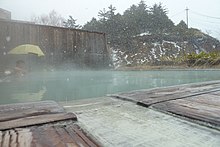Tsumagoi is in Gunma prefecture. It is known for its cabbages and many onsen.
Understand
[edit]
Parts of the village are within the borders of the Joshin'etsukogen National Park.
The main industries of Tsumagoi Village are agriculture and service industry. In agriculture, highland vegetables, mainly cabbage, are cultivated in high-cold regions, and it is famous as a cabbage village (the amount of cabbage produced and shipped is the largest in Japan). Its tourism industry draws visitors to a magnificent landscape, and natural environment such as hot springs.
Climate
[edit]In summer, the humidity is low and it is cool, making it a popular summer resort. On the other hand, it is extremely cold in winter, which is comparable to that of Hokkaido, and drops to around -15°C every year.
Get in
[edit]By train
[edit]Tsumagoi is on JR East's Agatsuma Line from Fukurogura to Manza-Kazawaguchi to Ōmae.
By car
[edit]National Routes 144, 146, 292 and 406.
By bus
[edit]- Seibu Kanko Bus
- JR Bus Kanto (Route Bus Takamine Kogen-Komoro Station / Sakudaira Station), (Highway Bus Takamine Kogen-Shinjuku Station)
Get around
[edit]See
[edit]Do
[edit]
- Enjoy the various onsen, including Manza, Kazawa, Tsumagoi and Handeki onsens. Manza onsen is particularly known as having the most acidic hot spring waters in Japan.
